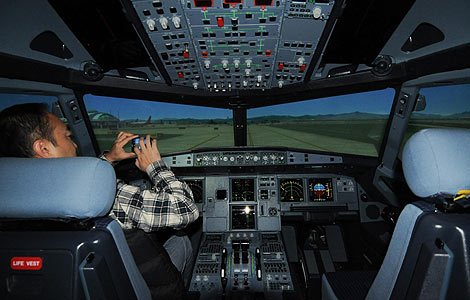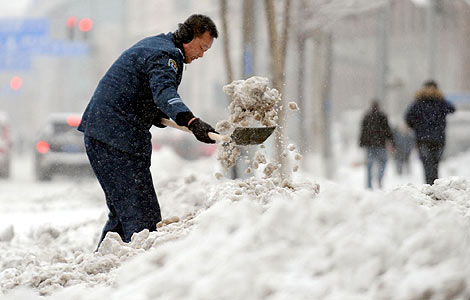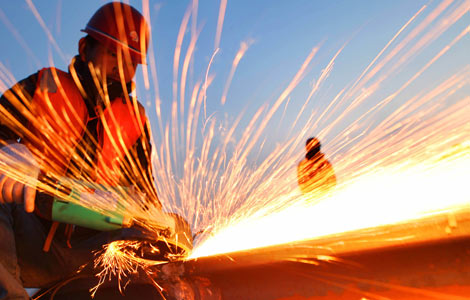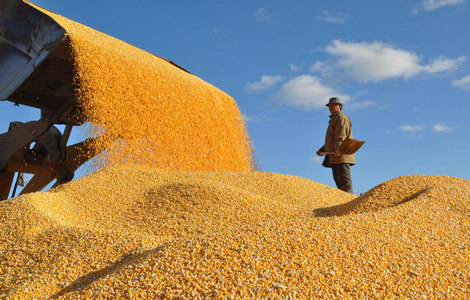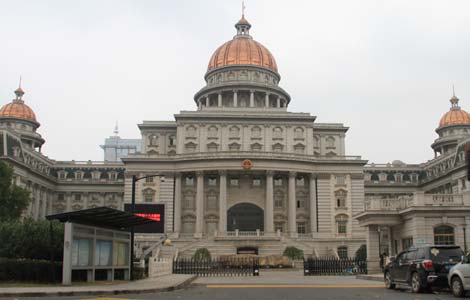
Tianhe-1A system helps Tianjin firm make animated film for DreamWorks
![Two staff members collect data in a computer room containing Tianhe-1A, China's fastest supercomputer, in Tianjin on Aug 28. [Photo/Xinhua] Supercomputer super stars](../../images/attachement/jpg/site1/20121007/0023ae9885da11db322213.jpg) |
|
Two staff members collect data in a computer room containing Tianhe-1A, China's fastest supercomputer, in Tianjin, on Aug 28, 2012. [Photo/Xinhua] |
If a Chinese supercomputer pops up in the credits at the end of a Hollywood film, don't be surprised, for China's Tianhe-1A, one of the world fastest supercomputers, is being used by a company in Tianjin to help create an animated film for DreamWorks.
"With the supercomputer's help, we've improved the rendering capability of DreamWorks," said Hu Yong, chairman of Cool Cartoon in Tianjin.
Hu said his company is now developing a data transmission system that will allow it to send rendered animations to its clients in North America faster in the future.
Tianhe-1A was developed to boost China's economic development and improve its scientific research capabilities, said Meng Xiangfei, head of the application department with the National Supercomputer Center in Tianjin, where Tianhe-1A is installed.
With the support of Tianhe-1A, a Chinese geographic information provider started the country's first official 3D map Tianditu - a Chinese version of Google Earth - which required an enormous number of calculations and data storage to create.
Compared with traditional two-dimensional maps, three-dimensional maps are more true to life, which offers users a more direct understanding of a real location, said Wang Jian, whose company provides a 3D map Tianditu of Tianjin.
"For example, if a house located in a block with interlaced streets catches fire, it is easier for firefighters to pinpoint the house's location and determine the quickest route to the fire using a 3D map."
In this way, the map not only makes firefighters' jobs easier, it can also help save people's lives, Wang added.
Wang said his team is now busy developing software to run on supercomputers that will improve the quality of the 3D map.
"The 3D map is really useful to me, because I find it difficult to relate ordinary maps to real streets. But the 3D map makes it easy," said Li Jing, who previously avoided driving in unfamiliar streets as she found it difficult to follow maps.
"I always thought the supercomputer was doing high-end scientific research. I never dreamed it would be part of my daily life," she added.
Thanks to its high performance, Tianhe-1A has also been boosting China's independent research and development capability in various industries and bringing more benefits to Chinese enterprises.
With Tianhe-1A's help, BGP, a geophysical service company affiliated to China National Petroleum Corp, China's largest oil and gas supplier, managed to eliminate China's dependency on overseas oil exploration technology.
"We now run independently developed software, which we used to have to buy from foreign companies, in Tianhe-1A to simulate underground geology," said Wu Wei, a manager from BGP.
"Using Tianhe-1A, we can conduct the simulation over a wider area and to a greater depth, which makes the exploration more accurate", he said, adding that the greater accuracy has increased the company's efficiency and saved it money.
"If we dig an oil well in the wrong place on land, we will lose tens of millions of yuan, and digging a well in the wrong place at sea can waste hundreds of millions of yuan," Wu said.
Like BGP, Tianjin Motor Dies Co Ltd will also save money, at least 3 percent of its production costs, thanks to Tianhe-1A's simulations.
"It's a large saving," said Chen Huibin, one of the company's experts in computer-aided engineering, "because our profit margins are only about 20 percent".
Meanwhile, the supercomputer is giving the company, which designs and manufactures car body panels and large stamping parts, a greater competitive edge.
After employing Tianhe-1A to simulate its stamping process, the company expects to increase its market share and "make the transition from offering low-end to high-end products", explained Chen.
Individuals can also use the supercomputer, according to Meng.
The level of supercomputer development in a country indicates its scientific research capabilities, so China's unexpected progress in developing supercomputers, Tianhe-1A beat supercomputers from the United States to be the world's fastest in 2010, caused an outbreak of anxiety in the US, which had long been the undisputed leader in supercomputers.
The US government responded by attaching more importance to the development of supercomputers, and the country reclaimed the world supercomputer crown in June this year using the Sequoia from the US Department of Energy's Lawrence Livermore National Laboratory in California.
The latest US supercomputer will be used to carry out simulations to help extend the durability of the US' aging nuclear weapons, avoiding the need for real-world underground tests.
Although Tianhe-1A had dropped to fifth place in the list of the world's fastest supercomputers published in June, it is still one of the fastest supercomputers in the world. However, related services, including software and data transmission systems, need to be further developed and improved in order to make the most of its formidable computing power.
zhouwa@chinadaily.com.cn


